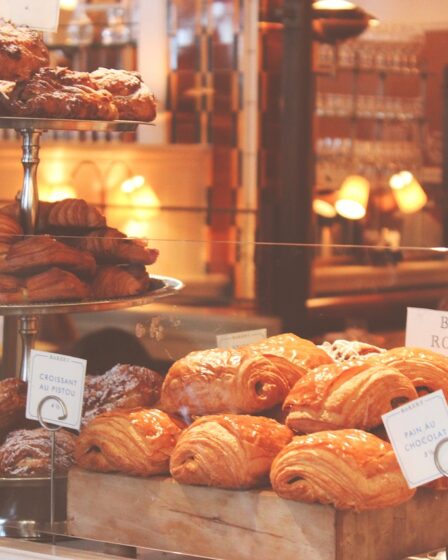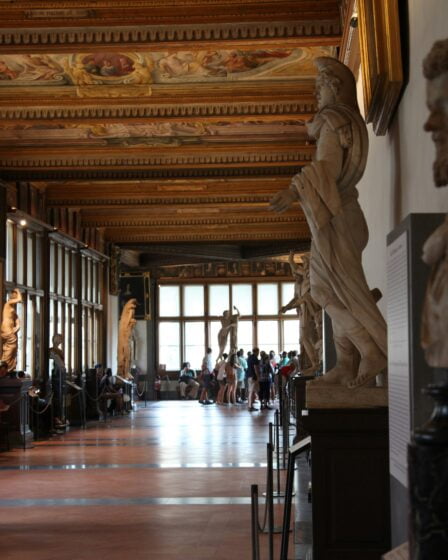The restoration works of the external part of the Loggia del Bigallo in Piazza San Giovanni are finished: the first part of the interventions that will allow the Bigallo to return to shine in the center of Florence. On this occasion, now it is possible to see again the fresco that is located on the first floor of the history of San Pietro Martire and the devil. The Loggia del Bigallo was built between 1353 and 1358 instead of the Torre degli Adimari house, driven out of Florence during the wars between Guelphs and Ghibellines. The loggia was built for the Bigallo company and for the Compagnia della Misericordia, two institutions founded by San Pietro Martire who dealt with orphaned and abandoned children. The name “Bigallo” derives from two cockerels on the company’s coat of arms. According to the legend, the loggia rises at the point of the miracle that St. Peter Martyr made in Florence.
Febbraio 2024
Lenoard and its idea to lift up the Baptistery
asari writes in 1550 about Leonardo: «And among these models and drawings there was one, with which several times ingenious citizens who then governed Fiorenza, showed wanting to raise the temple of San Giovanni di Fiorenza, and submit the stairs there without rearing it; And with so strong reasons it persuaded him, who seemed possible, although each, then that he had started, knew for himself the impossibility of a cotant company “. In reality, Leonardo’s project already had precedents: a few years earlier, in 1455, the Bolognese engineer and architect Aristotile Fioravanti (c. 1415-1486) with rollers, beams and Martinetti, had successfully moved a tower in Bologna . The latter had among other things worked for Leonardo’s friends or clients, such as the Bentivoglio, King Mattia Corvino of Hungary and Cosimo de ’Medici (between 1458 and 1467 in Florence). Leonardo’s project provided to raise the baptistery on four steps, as can be seen in a design attributed to Francesco Granacci (which is preserved in the cabinet drawings and prints of the Uffizi)
The Arch in Piazza della Repubblica
The massive structure, constructed in 1895 as part of an architect Vincenzo Micheli project, is referred to as the picturesque fifth of the square; its history dates back to 1883, when the Jewish ghetto and ancient market were demolished. The architecture of the palace goes beyond its function as a civilian residential building in the bourgeois sense. It becomes a monumental urban sign that imposes itself for the large arcone that he enters through Strozzi. The facades of the side buildings are developed to understand the two orders that each develop for six additional axes, the last of which are in the argument. Following that, each of these lateral bodies grows thoroughly in its own isolation, on two internal brief that go to the route Brunelleschi, and on one of an elongated shape towards via Pellicceria.
Museo della Specola reopen
It is one of the oldest scientific museum in Europe and on February 21, after four years of work, its suggestive rooms reopen, rich in anatomical and botanical waxes. In preview, the spectacular of Palazzo Bini Torrigiani in via Romana was visited by the President of the Republic Sergio Mattarella in the Tuscan capital on 8 February for the hundred years of the University of Florence.
Calcio Storico in Florence
From manifestation of republican power first and then Medici, reserved for the scampols of the noblest and most popular families, to popular tradition par excellence of Florence. From ball game that took place in many other cities in the Middle Ages, to the element of the Florentine DNA. With a cancellation of over two centuries that changed its soul but paradoxically made it more real precisely because it was reinvented. In short, a true invention, a “legend” that like all legends has profound elements of the territory it expresses.
Vienna the great battle 1683
September 1683, many meaning nothing …. but in that month or between 11 and 12 September a battle took place to say the least epic between the Polish-Austro-German army commanded by the Polish King Giovanni III Sobieski against the ‘Army of the Ottoman Empire commanded by the Grand Visir Merzifonlu Kara Mustafa Pasha. It may seem what nothing of nothing, but in reality thanks to this battle the inexorable push of the Ottoman expansion in Europe stops. But what does all this have to do with the city of Florence?
San Valentine on the top of Florence
One of the most requested appointments from Florentine lovers also returns this year: the toast on the Torre di Palazzo Vecchio. On February 14, on the occasion of the Valentine’s Day, the party of lovers, the Municipality of Florence and Mus.e propose a special afternoon dedicated to those who love each other. To all couples, from 19 to 20:30 (reservations required, limited places) will be given the unmissable opportunity to visit the walkway of Ronda and the Torre di Palazzo Vecchio, until it reaches its top along the stone staircase consisting of 223 steps that allows you to reach the last level of sighting, from which you can enjoy a wonderful 360 ° view of the city.
Best Schiacciata alla Firentina 2024 is…
In Florence, the best Fiorentina crushed is eaten at the Gilli Caffè in Piazza della Repubblica, a historic place that won the 2024 edition of the competition dedicated to the traditional city recipe. But in this sweet top 3 there are also other “sacred monsters” of taste. The contest, which has been taking place for 17 years now and is organized by the House of the In the and Festival of the pastry shops, has seen the participation of over 50 realities between pastry shops and ovens of Florence and its province. Among all the requests 30 finalists were selected.
History of a fake painting and is author
What we see in the photo is not the famous Raffaello masterpiece that many of you will certainly have already admired to the Uffizi. It is a copy and is located in the National Gallery of Capodimonte in Naples. It is said that one day Federico Gonzaga visiting Florence had been amazed by the beauty of this picture performed by Raffaello on behalf of Pope Leo X who had made himself portrayed together with the cousin Cardinal Giulio dei Medici (that is, the one destined to become Pope Clement VII) And to the other cardinal/cousin, Luigi de ‘Rossi. Federico Gonzaga asked that picture as a gift and Clement VII told him yes. When Ottaviano dei Medici he knew him a blow: no, he could not let herself leave lightly the masterpiece. So it was that Ottaviano decided to deceive the Pope, asking him for permission to be able to take the picture to equip him with a more beautiful frame. In reality Ottaviano called in secret Andrea del Sarto to make a copy, a copy that had to be perfect. Andrea del Sarto performed it. The result is what we see in the photo: I challenge anyone to recognize it from the original of Raffaello. The “crust”, if you can speak of crust, was sent to Mantua. Among other things, Giulio Romano, ex-Collaborator, indeed, worked in Mantua, indeed, Raffaello’s right arm, who had also taken part in the drafting of the original picture. It seems that not even he realized that it was a copy, so much had been well performed by Andrea Del Sarto who was not for nothing, the “painter without errors” was nicknamed.
Morgante dwarf at the Uffizi Gallery
Reunited at Palazzo Pitti, the mythical figure who was Bartolo’s arm for much of his life, is the picture of the dwarf Morgante, the most well-known of the five buffoons who resided at the court of Cosimo I de ‘Medici. “Thereupon, he depicted Bronzino to the Duke Cosimo, Morgante Nano, Ignudo, and the entire scene in two different ways, i.e., the front and the back of the painting, with that extravagant display of hideous appendages that has that dwarf: what painting in that genre is lovely and amazing” (Vasari, Bronzino’s life). Given that he was not permitted to hunt for larger game, the painting, which is painted on both sides, shows the dwarf as a “bird,” or bird hunter. In the two moments of action that follow, the character is seen from the front and the rear, respectively. Before going hunting, the character is shown holding an owl that is being used as bait to draw an acorn that is flying through the air. The genitalia are coated in two podaliric butterflies that were just found during the repair. proudly reveals the prey while turning to face the observer from behind. Painting a piece from several views on Bronzino, at the time of the litigation about the “comparison” (i.e., the argument over which art form is superior, painting vs. sculpture), provided the facts in response to those who argued that statuary was superior since it provided a greater variety of viewpoints. The picture is now on display at the Palatina Gallery’s Apollo room.









